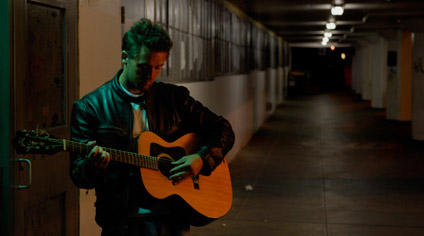Better to Travel: Option 3 (Dir. Richard Wong, 2008):
“So have you thought about what I said?”
— Jessica, Option 3
I seem to be one of the not-so-proud few who witnessed the world premiere of Richard Wong’s latest film Option 3 without having seen his first indie feature, Colma: The Musical, which I am told is charming and inventive (it’s already in the Netflix queue). Wong is clearly on the rise, with Colma‘s success and a recent collaboration with Wayne Wang on Princess of Nebraska, and from Option 3 it’s easy to see why. He assured the audience before the film started that this latest project is nothing like the earlier one, although it does have a musical number in the middle, and that it is as far from a commercial, marketable project as one can get. Nevertheless it’s a bracing work, and a good opportunity to see what San Francisco indie filmmaking is like circa 2008.
The film starts with the above quotation: we are at a restaurant, and Jessica (Theresa Navarro) has just popped a question in the face of Ken (Preston Connor), and after an uneasy silence, he excuses himself to go the bathroom. When he returns, Jessica has disappeared but her cell phone remains; a mysterious caller known as “Bison” orders him on a Quixotic quest for a McGuffin-like package if he wants to ever see her again.
 From there the chase is on, through the nocturnal streets of San Francisco, and we hop across genres and moods: Wong clearly loves the kinetic energy of Run Lola Run and the nightmare-logic disorientation of David Lynch, as Ken dashes from location to location, seeking red and green keys that unlock doors and boxes. Rigorous in its geographic consistency, we follow him from the Mission through downtown SF, down the Broadway Tunnel, through the Pacific St. Playground and back to SOMA before a final chase through Golden Gate Park that climaxes on Ocean Beach. Highlights include a disorienting scene on a merry-go-round (and few things are as creepy as a merry-go-round at night), and a long, uninterrupted Scorcese-style take as Ken maneuvers himself around a ballroom where Chinese oldsters practice their ballroom dancing, leading to a shocking bit involving a stairway and a closed door. Seeping through it all is the sense that Ken has failed Jessica, that he has failed in the relationship somehow, as shards of memory (and a few choice Emily Dickinson quotes – “some say the word is dead”) interrupt the narrative. Speaking of interruptions, the most memorable moment occurs when Ken stumbles upon a random acoustic guitar and launches into an (imagined) musical number with the homeless folks at the Transbay Terminal, a mournful plaint for his lost love.
From there the chase is on, through the nocturnal streets of San Francisco, and we hop across genres and moods: Wong clearly loves the kinetic energy of Run Lola Run and the nightmare-logic disorientation of David Lynch, as Ken dashes from location to location, seeking red and green keys that unlock doors and boxes. Rigorous in its geographic consistency, we follow him from the Mission through downtown SF, down the Broadway Tunnel, through the Pacific St. Playground and back to SOMA before a final chase through Golden Gate Park that climaxes on Ocean Beach. Highlights include a disorienting scene on a merry-go-round (and few things are as creepy as a merry-go-round at night), and a long, uninterrupted Scorcese-style take as Ken maneuvers himself around a ballroom where Chinese oldsters practice their ballroom dancing, leading to a shocking bit involving a stairway and a closed door. Seeping through it all is the sense that Ken has failed Jessica, that he has failed in the relationship somehow, as shards of memory (and a few choice Emily Dickinson quotes – “some say the word is dead”) interrupt the narrative. Speaking of interruptions, the most memorable moment occurs when Ken stumbles upon a random acoustic guitar and launches into an (imagined) musical number with the homeless folks at the Transbay Terminal, a mournful plaint for his lost love.
Even as it cribs from a multitude of sources, it’s clear that as a visual stylist (he is also the director of photography), Wong has talent to burn. Unerring in his close-ups and movements, his mix of light and shadow in stairways and alleyways, his ability to wring the most interesting image out of his budget-conscious cameras and setups, he transforms San Francisco into an urban wonderland, velvet-dark and dangerous (and as a long-time SF resident, I can say how difficult that can sometimes be – I don’t think I’ve seen The City look this sinister since Fincher’s The Game). For most of Option 3 we’re carried along on this quest, as unspecific as it may be (nothing in the plot or character relationships is necessarily explained), purely because of the rush of images.
Wong does overplay his hand at the climax, when Ken faces down Bison’s kung-fu-savvy right-hand man in a manic bicycle chase and fist fight that seems better suited for a more straightforward satire – coming on the heels of the feelings of loss and isolation that permeate the rest of the film, it does feel a bit “boys’ own adventure,” like something an 8-year old might come up with to conclude a film. Likewise, the finale on Ocean Beach is meant to be tragic but doesn’t necessarily communicate much besides the idea of “taking it like a man” when you’ve screwed up a relationship. Director Wong and co-screenwriter H.P. Mendoza freely admitted after the screening that much of the story was made up as they went along, and that it was a response to Wong’s own feelings of loss and responsibility after the break-up of a recent relationship. As such, perhaps Option 3 can be forgiven for its workbook-like quality, and its somewhat clunky approach to its main themes. As a process without a fully satisfying conclusion, Option 3 is fascinating; if Wong can get hold of a screenplay that allows him to utilize his cinematic talents unfettered, watch out.

